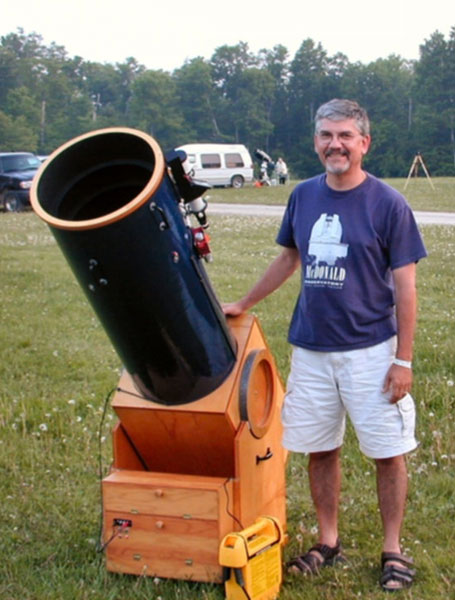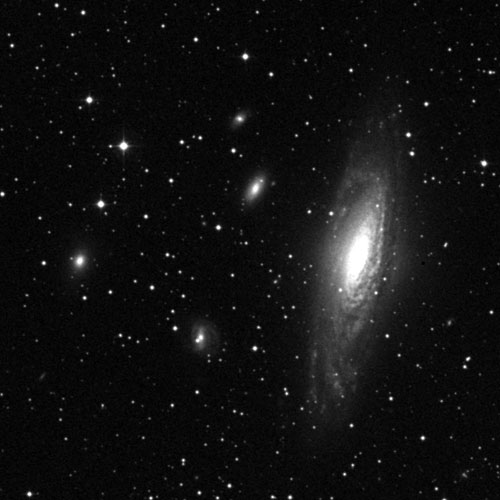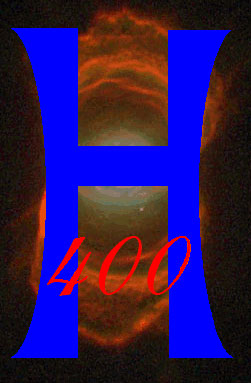


No, I’m not talking about your buddies who keep you company during observing sessions at remote dark sky sites. Nor am I talking about your favorite stuffed animal (OK ladies, no wisecracks about your husbands!) that you like to take along with you along with the rest of your observing gear. Not even those pesky mosquitoes that seem to think of insect repellent as dessert. No, I’m talking about companion galaxies, and there are more out there within relatively easy reach of amateur sized telescopes than you may realize.
So what is a companion galaxy anyway? Large spiral galaxies are often accompanied by one or more smaller galaxies which are apparently gravitationally bound to the parent. These companions are most often small ellipticals or irregulars. For example, our own Milky Way hosts two notable companions, the Large and Small Magellanic Clouds, visible from more southern latitudes. Our home galaxy also hosts the Sagittarius Dwarf, which was only recently discovered because it lies beyond the obscuring dust near the Milky Way’s central bulge.
What I thought I’d do here is list a few more or less easily viewed galaxies and their companions. There may be other examples, but these are ones that I’ve observed myself. In all cases visual (not photographic) magnitudes are quoted.
M51 - Possibly the most famous example of companion galaxies is the Whirlpool Galaxy, AKA Messier 51, and its companion NGC 5195. NGC 5195, at magnitude 9.6, is easily seen just a few arc minutes to the north of its spectacular face-on spiral parent. It is bright enough to be seen in my 8x50 finder scope from a dark site. It measures about 6 by 5 arc minutes, and appears to be connected to M51 by a “bridge.” NGC 5195 has a high enough surface brightness that in larger scopes, say 25 cm (10 inches) and larger, you can see some detail in it at higher magnifications, although many observers don’t look at it very closely due to the more fascinating spiral arms in the main galaxy. Were it not for its glamorous neighbor, it would be a fine target on its own. This pair of galaxies lies in the constellation Canes Venatici, near the end of the handle of the Big Dipper.
M31 - Next on our list is the great galaxy in Andromeda, Messier 31. Most observers know about its two closest companions, M32 and M110, which are usually visited as a side trip when observing their show-off parent. M32, or NGC 221, is an elliptical galaxy that shines at magnitude 8.1. Measuring about 9 by 7 arc minutes, it has a high enough surface brightness that it can be seen in virtually any size telescope, given dark enough skies. At higher magnifications in larger apertures, M32 exhibits a very bright and concentrated almost star-like core. M110, or NGC 205, also at magnitude 8.1, is about double the dimensions of M32, and so has a much fainter surface brightness. In smaller apertures under poor skies it can sometimes be a challenge to find. It is also an elliptical, as are most companion galaxies, and does not show a lot of detail, other than a gradually brighter center.
But did you know that M31 also has two other companions that are within the reach of many telescopes? NGC 147, measuring about 14 by 8 arc minutes, and glowing at magnitude 9.5, has a very low surface brightness. NGC 185, at magnitude 9.2, and with dimensions of around 13 by 10 arc minutes, has a surface brightness only marginally better than NGC 147. You’ll need a fair amount of aperture and more importantly a dark sky to pluck these two out of the background. And don’t expect to see much if any detail in them either - you’ll do well just to see them. NGCs 147 and 185 lie about seven degrees to the north, so most observers don’t realize that they are gravitationally bound companions to M31. In fact, they’re not even in the same constellation, but actually lie within Cassiopeia.
NGC 7331 - By far, the spiral galaxy NGC 7331, in the constellation Pegasus, is not nearly as famous as M51 or M31, but it is still worth checking out. It’s not real spectacular; shining at magnitude 9.5 I find that in my 13-inch reflector it resembles the view of M31 in 35 or 50 mm binoculars. What makes it interesting is its four companion galaxies that lie less than 10 arc minutes away from it - all five can fit within the same medium-high power field of view. Unfortunately, none of the companions are very bright, so you’ll need plenty of aperture, say 30 cm (12 inches) or more, good optics, and dark skies, just to see three of the four. They are all quite small, about an arc minute or less along their largest dimension, so you’ll also have to use plenty of magnification to make them big enough to pick out from the background.
At magnitude 13.4, NGC 7335 is the brightest of the group. It lies just a few arc minutes to the northeast of NGC 7331’s core. It appears as an elongated patch with a brighter core. NGC 7340 lies maybe 10 arc minutes nearly due east of its parent’s core. Softly glowing at magnitude 13.7, its appearance is very similar to that of NGC 7335. By far, NGC 7337, at magnitude 14.4, is more challenging to spot. It showed up as just a smudge in my 13-inch reflector. It lies about five arc minutes to the southeast of NGC 7331’s core. Finally, NGC 7336, at magnitude 15.0, will elude all but the largest of amateur telescopes. It has about half the dimensions of NGC 7335 and lies another couple arc minutes northeast. I would think that NGC 7336 should be visible in a 40 cm (16-inch) or larger scope, given dark enough observing conditions. I’ve never picked it up in my 13-inch, but I’m not done trying!
Here’s a table with more information on the galaxies I described above:
| Name | Right
Ascension |
Declination | Magnitude | Dimensions | Position Angle |
Surface Brightness (magnitudes per square arc minute) |
|---|---|---|---|---|---|---|
| M51 (NGC 5194) | 13h29m | 47^11’ | 8.4 | 10.8’ x 6.6’ | 163 | 12.9 |
| NGC 5195 | 13h30m | 47^15’ | 9.6 | 5.9’ x 4.6’ | 79 | 12.9 |
| M31 (NGC 224) | 0h42m | 41^15’ | 3.4 | 189.1’ x 61.7’ | 35 | 13.5 |
| M32 (NGC 221) | 0h42m | 40^51’ | 8.1 | 8.5’ x 6.5’ | 170 | 12.4 |
| M110 (NGC 205) | 0h40m | 41^40’ | 8.1 | 19.5’ x 11.5’ | 170 | 14.0 |
| NGC 147 | 0h33m | 48^29’ | 9.5 | 13.5’ x 8.2’ | 25 | 14.5 |
| NGC 185 | 0h38m | 48^19’ | 9.2 | 12.5’ x 10.4’ | 35 | 14.3 |
| NGC 7331 | 22h37m | 34^24’ | 9.5 | 10.2’ x 4.2’ | 171 | 13.3 |
| NGC 7335 | 22h37m | 34^26’ | 13.4 | 1.3’ x 0.6’ | 151 | 12.9 |
| NGC 7336 | 22h37m | 34^29’ | 15.0 | 0.4’ x 0.3’ | 135 | ? |
| NGC 7337 | 22h37m | 34^21’ | 14.4 | 1’ x 0.8’ | ? | 14.3 |
| NGC 7340 | 22h37m | 34^24’ | 13.7 | 0.9’ x 0.6’ | 160 | 12.9 |
As you can now see there’s nothing like a good companion or two while observing, so give these a try. If you know of others please let me know about them. I’d like to know - what do you see?

NGC 7331 and environs - image is from the Digital Sky Survey (DSS) (See http://www.sdss.org/). Also visible in this image is NGC 7335, NGC 7336, NGC 7337 and NGC 7340 all of which are described wonderfully by Doug Scobel.

Doug is a highly accomplished observer, who has an uncanny knack for finding very faint objects. Doug has observed and catalog the “The Herschel 400” was recognized and awarded by the Astronomical League and is currently working “The Herschel II” list of faint fuzzies and at the rate he is going someone will have to create a “Herschel III” list.